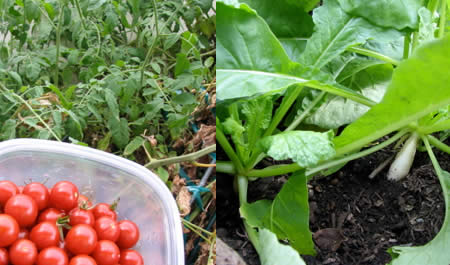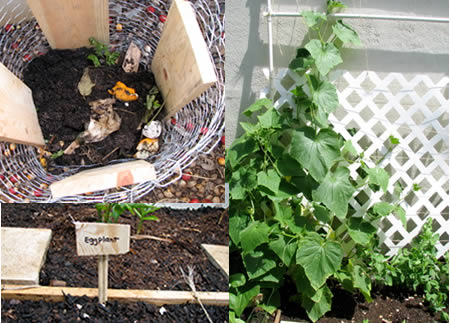The following is a guest post from my wife, aka Mrs. MMB. I was whining like a spoiled child about how I needed to write up extra posts for when we’re traveling this week, so she kindly offered up her own tips.

Jonathan and I love eating fresh foods, and it tastes even better when we harvest it straight from our yard. We don’t actually have much space – just a 9 foot wide strip of land next to our house – but our garden is now so plentiful, that we are able to incorporate fresh veggies and herbs into almost every meal that we cook at home. Although the initial start up costs added up (a new garden and soaker hose, soil, and seeds), here are some frugal gardening tips that I learned:
Buy seeds. Seeds take a little longer to grow, but are much cheaper than seedlings at Home Depot. For example, one packet of thirty bell pepper seeds cost $1.99, where as one seedling costs $.99 to $3.99, depending on the size of your seedling.
Trade seeds with your friends: I always have an excess of seeds (I don’t really need 30 bell pepper plants!), so I bring my seed packets and extra seedlings to work and trade them with friends and co-workers. I also like to trade cuttings with co-workers; mint and sweet potato are especially easy to grow from cuttings. That way, I always have a variety of seeds and plants on hand, all for a very reasonable price of free.
Make your own compost. Like any gardener, I have a daily battle with pests and clay soil, but I try to do everything organically with things like Neem oil and self-made compost. Compost enriches our soil, and it decreases the quantity of kitchen scraps that go into our trash. Coffee grounds are especially rich in nitrogen and something that I would have otherwise thrown out. I really dig the fancy commercial compost bins, but they can easily cost more than $100 for the bin. Instead, I made my own compost bin from extra pieces of plywood and chicken wire. There are a lot of DIY compost bin instructions on the internet. I’ll be upgrading to a bigger bin soon, but for now, my little bin produces nice earthy compost.

Recycle! I love the idea of reusing household trash, and I use take-out chopsticks to label plants, an old milk carton to collect kitchen scraps, a plastic orange juice container as my “watering can”, and as an alternative to expensive jiffy pots, I like to use egg cartons to plant seedlings. Recycling, can also provide excellent alternative to expensive bell jars: I recently had a problem with especially voracious pill bugs, and I now use old water and soda bottles as cloches and bell jars to protect the seedlings from the bugs.
I also wanted pretty trellises, but a fancy manufactured trellis, though very pretty, can be expensive. Instead, I made trellises with inexpensive PVC pipes and a recycled old plastic fence that we would have otherwise thrown out. I simply screwed the PVC pipe onto the fence and bought a couple of two-foot rebar poles ($2.99 each) to anchor the “new” trellis into the ground. Voila! A vertical space for cucumbers, peas, and morning glories for less than $10!
Overall, I spend a few hours every weekend weeding, sowing, transplanting, and tilling, and 15 minutes everyday watering and harvesting goodies for our dinner. While I agree that gardening is not for everyone, I find gardening a very relaxing and rewarding hobby.
 The Best Credit Card Bonus Offers – 2025
The Best Credit Card Bonus Offers – 2025 Big List of Free Stocks from Brokerage Apps
Big List of Free Stocks from Brokerage Apps Best Interest Rates on Cash - 2025
Best Interest Rates on Cash - 2025 Free Credit Scores x 3 + Free Credit Monitoring
Free Credit Scores x 3 + Free Credit Monitoring Best No Fee 0% APR Balance Transfer Offers
Best No Fee 0% APR Balance Transfer Offers Little-Known Cellular Data Plans That Can Save Big Money
Little-Known Cellular Data Plans That Can Save Big Money How To Haggle Your Cable or Direct TV Bill
How To Haggle Your Cable or Direct TV Bill Big List of Free Consumer Data Reports (Credit, Rent, Work)
Big List of Free Consumer Data Reports (Credit, Rent, Work)
Wow, great post with a lot of good information. While I personally can’t imagine ever actually wanting to garden, this article almost makes me wish I did.
My dream would be to have my own garden too.
Here’s a question about saving money on the cost of seeds? (And again, I’m no farmer)
You mention you save money buying seeds, instead of seedlings. Why not just buy a pepper and then remove the seeds? And then you can eat the pepper too.
Good post with great advice. If everyone did this, well, just imagine the possibilities. I’ve spent the last week taking out all the lawn in my front yard and putting in raised beds, herbs, and grapes. It looks great. Obviously I don’t have a home owners association to worry about, but even if you do, you can make small inroads by bordering with vegetables. Slowly expand the border over the years and people aren’t likely to notice as much. In fact, they may start to copy you.
@mike – I’m no farmer either, and I asked the same question. One term to look up is hybrid plants and seeds. Many things we eat now are hybrid plants used for mass production of food, where you often can’t use the seeds inside for the next generation. Some you can, though. Also look up heirloom seeds.
Have you looked into Square Foot Gardening? There are a few books by Mel Bartholomew. It’s great when you don’t have much room (and even when you do).
We use “Mel’s Mix” to plant the garden in (a three-part mix you make yourself). There is no dirt, so there are way fewer weeds than a normal garden has, and it was really easy to do. No weeds = not spending hours on the weekend weeding!
The book I use:
http://www.amazon.com/All-New-Square-Foot-Gardening/dp/1591862027
Do you own a tiller? Which one do you have?
Just got some seeds, but I’m not known for my planting skills. Guess we will see what happens.
@Sarah- I actually tried Square Foot Gardening last season. I liked the idea, but my tomato got unruly and took over a few extra squares and snuffed out my bush beans and eggplant. Bad planning on my part. I really like the idea of “Mel’s Mix” and will need to check it out..
@Larry- No tiller. Just my large pick and a hoe. I probably will never need a tiller, since my plot is so small, but if I ever do need a tiller, I’ll probably just rent one.
@Jared- Good for you! It’s fun to experiment with seeds. It’s a learning process, and I’m constantly learning each season.
I like your trellis idea. I did something a bit different. I bought spruce strapping ($1.89 for 12′ lengths at Home Depot or Lowes), bought a 100′ roll of 7′ wide nylon deer fencing ($20), and a 100′ roll of 14-guage wire ($7). Then: (1) I split 3 of the 3″ wide strapping, and cut them to 7′ lengths. (2) On one end, I drilled a 1/4″ hole 5 inches from the end. (3) I took 3 poles and ran a 1-foot length of wire through the holes and twisted the ends together. That gave me 3 7-foot poles wired together at one end, which I could spread apart at the other end to form a tripod. (4) Then I cut the deer fencing to the length I needed for my peas. (5) Since my tripods are about 6 feet high when set up, I folded over the top 1 foot of the 7-foot wide deer fencing and “sewed” it together by running twine over and under the squares. (6) I put a length of strapping through the tunnel (like threading a curtain rod through a curtain top), and put each end of the strapping on one of the tripods. (7) I cut 1-foot lengths of wire and bent them into “staple” shapes, and used them along the bottom of the deer fence to anchor it to the earth. Now my peas (and cukes) have something to climb. Though the cost of the deer fence was high for the amount of trellis I needed, I have replacement material for years to come, so it will average out over time. You can see pictures of my pea and cucumber trellises on my post “Views of the Garden, 2011” on my blog. (woodchucksapprentice.com) I’ll post an article on making the tripods and cross-beams soon, with photos of the steps.
@ Terry Bascom
Great pictures! I really like the tripod idea. I did something similar but with left over welded wire concrete mesh– I got a 6 foot panel and wrapped it into a cylinder. My pole beans love it, and it’s very good for caging my tomatoes. It does get little windy, so I’ve learned to steak them in with rebar.